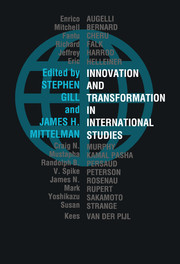Book contents
- Frontmatter
- Contents
- List of contributors
- Preface
- Acknowledgements
- Part I Rethinking and remaking the roots of global social and political theory
- Part II Political economy: the social and ecological anatomy of transformation
- Part III Transformation, innovation and emancipation in global political and civil society
- Part IV Reflections on global order in the twenty-first century
- 13 Civil society and democratic world order
- 14 Imposing global orders: a synthesised ontology for a turbulent era
- 15 The problem or the solution? Capitalism and the state system
- 16 Rethinking innovation in International Studies: global transformation at the turn of the millennium
- References
- Index of names
- Index of subjects
14 - Imposing global orders: a synthesised ontology for a turbulent era
Published online by Cambridge University Press: 05 July 2011
- Frontmatter
- Contents
- List of contributors
- Preface
- Acknowledgements
- Part I Rethinking and remaking the roots of global social and political theory
- Part II Political economy: the social and ecological anatomy of transformation
- Part III Transformation, innovation and emancipation in global political and civil society
- Part IV Reflections on global order in the twenty-first century
- 13 Civil society and democratic world order
- 14 Imposing global orders: a synthesised ontology for a turbulent era
- 15 The problem or the solution? Capitalism and the state system
- 16 Rethinking innovation in International Studies: global transformation at the turn of the millennium
- References
- Index of names
- Index of subjects
Summary
Even a realist like former Secretary of State Henry A. Kissinger is at a loss to describe the world in a comprehensive way. He told a conference in Washington recently: ‘It's probably not possible to have some over arching concept.’
Challenging as may be the task of accounting for the failure of students of International Relations to anticipate the end of the Cold War (Gaddis 1992/3; Rosenau, 1995b), that of comprehending the basic contours of global politics that have evolved since the Berlin Wall came down and the Soviet Union collapsed is both more difficult and important. If it is the case, as has been cogently argued, that the Cold War ‘left so light an impact on the living memory of states and societies, that it is already enroute to oblivion’ (Gambles, 1995: 35), then the need to pause and explicitly conceptualise the basic outlines of the global structures now emergent is all the more urgent. Not to do so is to run the serious risk of assuming that ‘the business of international politics is being conducted as if there were continuity between the years before and the years after [the Cold War], as if history was being resumed’ (1995: 27) – an assumption that is clearly too simple and ignores the social, economic, political and technological transformations that have unfolded in the last fifty years (and that, indeed, significantly contributed to the end of the Cold War).
- Type
- Chapter
- Information
- Innovation and Transformation in International Studies , pp. 220 - 235Publisher: Cambridge University PressPrint publication year: 1997
- 1
- Cited by



